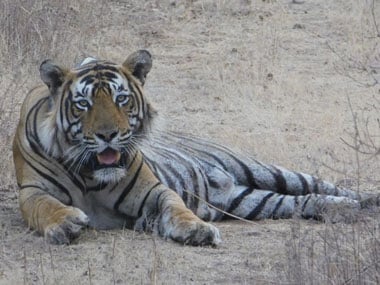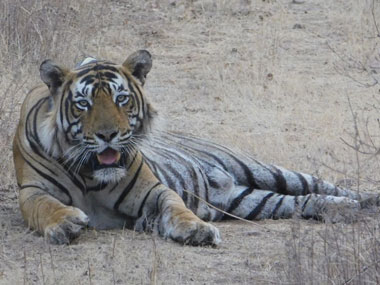A tigress and her two cubs dying outside the boundary of Tadoba Tiger Reserve in Maharashtra early this week, by several accounts an instance of revenge poisoning for having killed a village cattle, is actually a big optical illusion at play. The fact is the ghastly incident has as much to do with official apathy as with the booming tiger population all over India. [caption id=“attachment_4658171” align=“alignleft” width=“380”]  A tiger at the Ranthambore reserve. Firstpost/Ankita Virmani[/caption] Add to this the lackadaisical legal system which is woefully inadequate to nail the culprits, a marked failure to pursue the case against the accused till their conviction and virtually letting them walk free. There are reasons why people are getting more emboldened to kill the big cats once they step outside the tiger reserve. Sariska is a case in point. Immediately after the tiger re-introduction project there, three tigers brought there from Ranthambore died at the hands of poachers. And pray, what happened after that? Till date, not a single accused has been proven guilty – so much for the prosecution’s resolve to punish the killers. It appears that at different intervals, the three had ventured outside the boundary of Sariska, in the process becoming an easy target for the poachers. In all likelihood, this is what happened with the tiger family of Tadoba. The trio came out of the boundary of the reserve and paid with their lives. The great conservationist Billy Arjan Singh had aptly coined the phrase “forgotten tigers” for the big cats which strayed outside of their home turfs and never returned. Early this year, a tiger moved into Gujarat and died of starvation. Where he came from and what prompted his remarkable peregrination will forever be shrouded in mystery. Before that, the popular tiger Broken Tail of Ranthambore took a long walk outside the reserve and got knocked down by a Rajdhani Express train some 150 kilometres away from its lair. Is it possible that the same deathwish might have come upon the Tadoba tigress and her youngsters? Chances are, they had no option but to move out of Tadoba. Shalik Jogwe, a tiger enthusiast from Tadoba, says that of late a number of tigers had left the reserve. “The tiger population in the reserve is increasing. The young and the less powerful tigers are forced to move out by their more powerful and dominant brethren,” points out Shalik. This brings us to the bigger question of what exactly is happening in the world of Indian tigers. Unlike the situation of a few years ago when they were on the brink of extinction, the tigers in India have made a spectacular comeback. Not only has their population increased, but many national parks are beginning to face the problem of plenty. Facing stiff resistance from the resident tigers, which are inherently territorial in nature, the younger or the weaker tigers are left with no choice but to move out of the reserve. Several tiger reserves such as Ranthambore, Corbett, Tadoba, Bandhavgarh have been witnessing this spillover phenomenon. From the outskirts of Bhopal to the high-altitude Kedarnath Wildlife Sanctuary tigers have started popping up in the unlikeliest of places. Now, this is where India’s flagship species gets the dirty end of the stick. Once it moves outside the protected area, a tiger is left to fend for itself. Compared to the designated tiger reserve, it doesn’t stand a ghost of a chance in the terra incognita of the outside world, where neither humans nor animals are safe. The skeletal forest staff in these mofussil regions is woefully ill-equipped to protect the tiger. In most cases anyway, their priority is to push the feline back into its forest, rather than throw a protective ring around it and ensure that it does not fall prey to bullet, snare or poison. The skewed compensation mechanism, which entitles a cattle owner for compensation if it’s killed by a wild animal, has a large role to play in most cases of tiger poisoning. If the cattle get killed at the boundary of a tiger reserve or in the buffer zone, the affected villagers get compensation by the forest department. But nothing is given if the killing takes place beyond the buffer zone. The agitated farmer is then left with one mean of retaliation: put insecticide in the carcass of the dead cattle. This is what exactly what happened outside Tadoba on Monday. Known for easy sightings of its big cats, the Tadoba Andhari Tiger Reserve in the Chandrapur district of Maharashtra has emerged as one of the finest tiger destinations of India. It shot past the popularity scale during the past decade, and a series of protective measures within the reserve led to a sizable increase in its tigers. This, unfortunately, led to the “spillover” effect for which Tadoba has been praying the price at fairly regular intervals. The tigress and her two cubs (a male and a female) died around 70 kilometres from the boundary of the tiger reserve. Village Metapur in the Chimur forest range, where the poisoning took place, falls under Brahampuri division. Interspersed with some 500 villages, Brahampuri division is certainly not an ideal abode for tigers. But the tigers which repeatedly get edged out of the safe zone of Tadoba have only place to go to – Brahampuri. Over the years, this division has emerged as number one killing field of tigers. In December last, a tiger was claimed by the poachers here. Home to some of the most famous tigers such as Maya, Madhuri and Waghdoh male, Tadoba also has a soft underbelly. Protecting them inside the reserve is not so much of an issue. It’s what happens to them after they cross the lakshman rekha of safety that the real danger comes. The same script, at different locations and with different tigers, is being played out at many other places in India.
The skewed compensation mechanism, which entitles a cattle owner for compensation if it’s killed by a wild animal, has a large role to play in most cases of tiger poisoning.
Advertisement
End of Article


)

)
)
)
)
)
)
)
)



